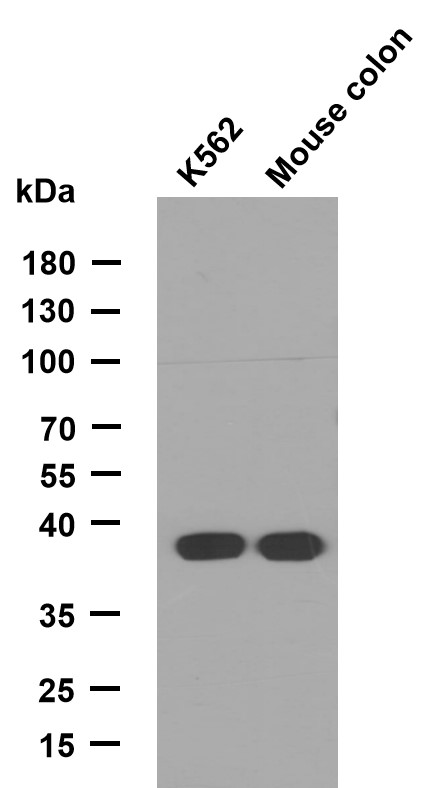GST-Pi (ABT-GSTP1) mouse mAb
- Catalog No.:YM6765
- Applications:IHC;ELISA
- Reactivity:Human;
- Target:
- GST-Pi
- Fields:
- >>Glutathione metabolism;>>Metabolism of xenobiotics by cytochrome P450;>>Drug metabolism - cytochrome P450;>>Drug metabolism - other enzymes;>>Metabolic pathways;>>Platinum drug resistance;>>Pathways in cancer;>>Chemical carcinogenesis - DNA adducts;>>Prostate cancer;>>Hepatocellular carcinoma;>>Fluid shear stress and atherosclerosis
- Gene Name:
- GSTP1 FAEES3 GST3
- Protein Name:
- GST-Pi
- Human Gene Id:
- 2950
- Human Swiss Prot No:
- P09211
- Immunogen:
- Synthesized peptide derived from human GST-Pi AA range: 150-210
- Specificity:
- The antibody can specifically recognize human GST-Pi protein.
- Formulation:
- PBS, 50% glycerol, 0.05% Proclin 300, 0.05%BSA
- Source:
- Mouse, Monoclonal/IgG1, kappa
- Dilution:
- IHC 1:200-400. ELISA 1:500-5000
- Purification:
- The antibody was affinity-purified from ascites by affinity-chromatography using specific immunogen.
- Storage Stability:
- -15°C to -25°C/1 year(Do not lower than -25°C)
- Other Name:
- Glutathione S-transferase P (EC 2.5.1.18;GST class-pi;GSTP1-1)
- Molecular Weight(Da):
- 23kD
- Observed Band(KD):
- 26kD
- Background:
- Glutathione S-transferases (GSTs) are a family of enzymes that play an important role in detoxification by catalyzing the conjugation of many hydrophobic and electrophilic compounds with reduced glutathione. Based on their biochemical, immunologic, and structural properties, the soluble GSTs are categorized into 4 main classes: alpha, mu, pi, and theta. This GST family member is a polymorphic gene encoding active, functionally different GSTP1 variant proteins that are thought to function in xenobiotic metabolism and play a role in susceptibility to cancer, and other diseases. [provided by RefSeq, Jul 2008],
- Function:
- catalytic activity:RX + glutathione = HX + R-S-glutathione.,function:Conjugation of reduced glutathione to a wide number of exogenous and endogenous hydrophobic electrophiles.,online information:The Singapore human mutation and polymorphism database,similarity:Belongs to the GST superfamily. Pi family.,similarity:Contains 1 GST C-terminal domain.,similarity:Contains 1 GST N-terminal domain.,subunit:Homodimer.,
- Subcellular Location:
- Cytoplasmic
- June 19-2018
- WESTERN IMMUNOBLOTTING PROTOCOL
- June 19-2018
- IMMUNOHISTOCHEMISTRY-PARAFFIN PROTOCOL
- June 19-2018
- IMMUNOFLUORESCENCE PROTOCOL
- September 08-2020
- FLOW-CYTOMEYRT-PROTOCOL
- May 20-2022
- Cell-Based ELISA│解您多样本WB检测之困扰
- July 13-2018
- CELL-BASED-ELISA-PROTOCOL-FOR-ACETYL-PROTEIN
- July 13-2018
- CELL-BASED-ELISA-PROTOCOL-FOR-PHOSPHO-PROTEIN
- July 13-2018
- Antibody-FAQs
- Products Images

- Human esophageal squamous cell carcinoma tissue was stained with Anti-GST-Pi (ABT-GSTP1) Antibody

- Human esophageal squamous cell carcinoma tissue was stained with Anti-GST-Pi (ABT-GSTP1) Antibody



